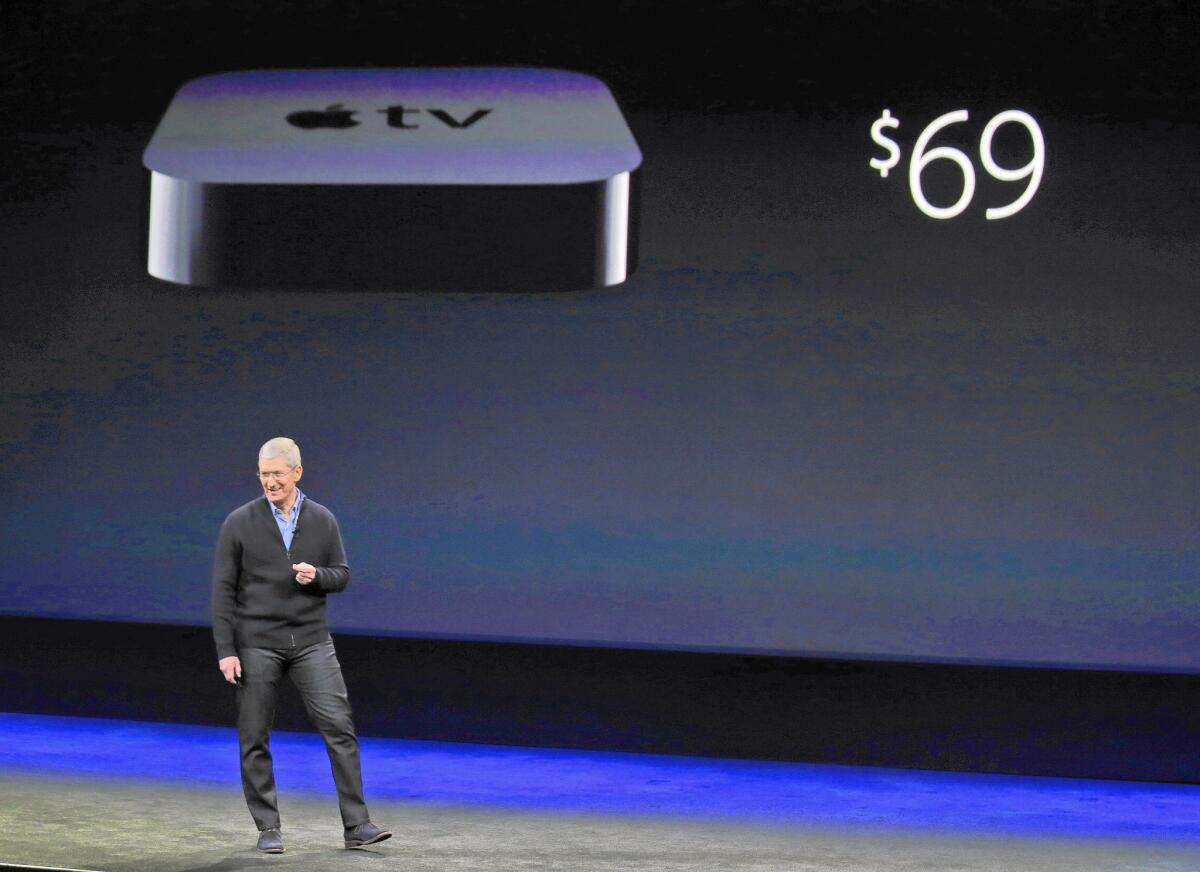Apple TV ‘skinny’ package likely to accelerate cord cutting

- Share via
Apple’s ambition to be a dominant player in television is expected to accelerate the unraveling of the pay-TV bundle.
The tech giant is in negotiations with major television companies to offer a “skinny” package of channels that would include ABC, CBS and Fox Broadcasting, according to people familiar with the matter who were not authorized to speak publicly. Apple wants to roll out the service in time for the new fall shows in September.
The proposed streaming service takes aim at the 10 million homes that have high-speed Internet and no pay television programming, along with customers who are fed up with high cable fees. Apple’s cachet and legions of loyal fans could make it one of the biggest threats yet to cable and satellite operators.
“Apple remains one of the few companies in the world that has the potential to transform the TV industry, and we believe consumers are ready for a change,” Cantor Fitzgerald analyst Brian White wrote Tuesday in a research report.
The company is the latest to stake its claim in the fast-growing market of Internet television services.
Netflix and Amazon.com already offer subscription services, and Sony Corp. plans to launch its own TV offering for its PlayStation game console. Dish Network last month rolled out its Internet-delivered service called Sling TV that starts at $20 a month.
Apple last week unveiled its deal to offer HBO Now, a $14.99-a-month Internet streaming service on Apple devices beginning next month. Its planned Web TV subscription service would cost customers about $30 a month, the people said.
Any new subscription service ultimately would be designed to spur sales of the company’s Apple TV device, which some consumers could use to replace their cable box. Last week, Apple Chief Executive Tim Cook slashed the price of the device to $69 from $99.
The recent moves should help prompt cable and satellite TV providers to offer their customers smaller packages of services at lower price points to remain competitive. Consumers for years have been grousing about the high cost of subscriptions that include hundreds of channels they never watch.
“The floodgate is now open,” CBS Chief Executive Leslie Moonves said during a recent investor conference. “Clearly the bundle is changing.... The days of the 500-channel universe are over.”
After years of false starts, Apple finally is getting traction with programmers that previously rebuffed its overtures. These programmers, including CBS and Fox, don’t want to get left behind as consumers find ways to cut through the cable clutter.
Apple is willing to pay up to provide the channels — and that makes business sense for the programmers in an era of declining ratings and ad revenue.
Apple, CBS, ABC and Fox on Tuesday declined to comment on discussions, which were first reported by the Wall Street Journal.
It was unclear Tuesday exactly which TV networks would be included in the proposed Apple service. Apple is said to be focusing on deals with companies such as 21st Century Fox that own both a major broadcast network and cable channels.
NBC is not in discussions with Apple. However, as part of a 2011 agreement with the federal government, NBC’s parent company, Comcast Corp., is legally obligated to provide its programming to Internet services if NBC’s rivals also participate.
The new service also might not include regional sports channels, which have helped drive up the cost of pay TV in recent years.
But analysts are not ready to write the obituary for the pay-TV industry just yet.
“We are going to see an increase in cord cutting, but it’s not going to be dramatic,” predicted James McQuivey, an analyst with Forrester Research. “The main reason it won’t be dramatic is there is no way to cut the cord and still get everything you want.”
For example, Dish’s Internet streaming service, Sling TV, offers ESPN, ABC Family, Cartoon Network and Food Network — but not ABC and CBS.
Dish introduced the service last month to appeal to budget-conscious consumers and apartment dwellers unable to install an antenna on their roof. Sling TV, which starts at $20, allows consumers to add packages like sports and lifestyle programming for an additional $5 a month.
Analysts point out that the low cost might be deceiving.
People still would have to turn to cable and phone companies for their Internet service, some of which tack on fees if users exceed established data caps. This could be easy to do when users are spending hours streaming TV shows and movies.
Cable TV distributors also are expected to fight back by making their bundles of Internet and TV channels “economically attractive as a way to retain consumers,” Nomura Securities analyst Anthony DiClemente said.
Switching to a broadband-only package might save customers about $30 to $50 a month at current promotional rates, but adding Apple’s Web TV Service, Netflix and HBO Now “quickly erodes those savings,” DiClemente said.
Cable companies already have gotten the memo.
For example, Comcast has a promotional Internet service plus TV package for about $40 a month. The slimmed-down package has 25 channels, including ABC, CBS, NBC, PBS and HBO.
Cox Communications, which provides cable service in Orange County, has a low-cost option that includes high-speed Internet, basic TV channels and premium networks HBO and Starz at a promotional rate as low as $69 a month.
Apple has had a slow march into TV. When it was launched in 2007, the Apple TV box was billed as a way to purchase movies and TV shows from iTunes and display it on a television set.
At the time, broadcasters showed little interest, objecting to the a la carte nature.
But now, ESPN, Bloomberg TV and others offer content that can be seen live through Apple TV apps.
Despite persistent rumors about manufacturers in Apple’s Asian supply chain revving up Apple-branded television sets, neither a display nor a newly designed Apple TV streaming box has appeared on the shelves.
The current Apple TV device is capable of streaming dozens of channels, but the recent price cut for the box has stoked speculation that a new version could debut later this year.
A newer box might handle ultra-high-definition resolution, which provides a step up in picture quality. Experts think that Apple’s advantage comes from its strong track record of developing products that have clean and user-friendly designs.
“They do have this very loyal fan base and a great usability that’s not possible in the more fractured environments of other devices,” said Field Garthwaite, chief executive of Iris.Tv, a Los Angeles start-up that builds video recommendation technology.
Staff writer Yvonne Villarreal contributed to this report.
More to Read
Inside the business of entertainment
The Wide Shot brings you news, analysis and insights on everything from streaming wars to production — and what it all means for the future.
You may occasionally receive promotional content from the Los Angeles Times.












